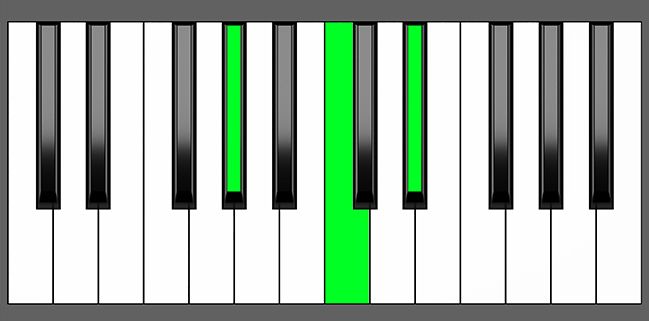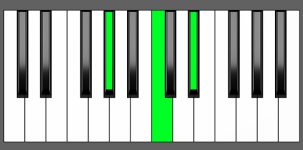Piano Diagram of G# Maj in Root Position

To get a G-sharp major chord, you combine the root (G#), the 3rd (B#, which is equivalent to a natural C), and the 5th note (D#) from the G# Major diatonic scale. In other words, a G-sharp major chord is a major triad built upon the key of G#. Keep reading to get a better grip on the music theory behind this chord.
Structure of G# Major
Notes |
|---|
| G#, B#, D# |
Intervals |
|---|
| R, 3, 5 |
Fingers Position
Left Hand |
|---|
| 4, 2, 1
5, 3, 2 |
Right Hand |
|---|
| 1, 2, 4
1, 3, 5 |
G# Major Chord Inversions
The G-sharp major chord has a total of 2 inversions:
| Root Position: | G# | B# | D# |
| 1st Inversion: | B# | D# | G# |
| 2nd Inversion: | D# | G# | B# |
Piano Keyboard Diagrams
Music Theory and Harmony of G# Major
What are Major Chords?
Major chords are one of the two primary types of chords in music, along with minor chords. The primary distinction between the two lies in the 3rd note of the chord – major chords use a major 3rd, while minor chords use a minor 3rd. Due to the major third interval, major chords generally evoke a “happy” or “bright” quality, creating a sense of stability and resolution.
Building the G# Major Chord: Different Approaches
Starting from the G# Major Scale
To build a major chord, you can use the major scale as a reference. You will need to combine a root, a major 3rd, and a 5th interval.
For instance, to build the G-sharp major chord, you can start with the G# Major scale.


To create a G-sharp major chord, apply the formula R, 3, 5 in the following manner:
- Begin with the root note, which is G#.
- Select the major 3rd interval, which is B#, and add it to the chord.
- Finally, add the 5th interval, which is D#.
By following this simple formula, you can create a major chord from any major scale.
by Combining Intervals
One method to create a major chord is by combining specific intervals – a major 3rd, and a minor 3rd. For example, let’s consider the G-sharp major chord.
3 + m3 = Major Chords
By examining the intervals between the notes, we can see that G#-B# forms a major 3rd interval, and B#-D# creates a minor 3rd interval. These two intervals can be stacked together to create the G-sharp major chord.
G# Maj in a Chord Progression
The following tables display the harmonization of major and their relative natural minor scales for keys that contain a G-sharp major chord in different positions (degrees of the scale).
G# and D# major are considered theoretical keys. Instead of using the G# major chord, its enharmonic equivalent, Ab major, is more commonly used, especially in those keys where the number of flats is significantly lower. Same thing for the D# major key; we will refer to the key of Eb major.
on Major Scales
| Major Scales | I | ii | iii | IV | V | vi | vii |
|---|---|---|---|---|---|---|---|
| G# = Ab | Ab Maj = G# Maj | Bb min | C min | Db Maj | Eb Maj | F min | G dim |
| D# = Eb | Eb Maj | F min | G min | Ab Maj = G# Maj | Bb Maj | C min | D dim |
| C# | C# Maj | D# min | E# min | F# Maj | G# Maj | A# min | B# dim |
- Tonic chord in G# Major as Ab Maj
- Subdominant chord in D# Major as Ab Maj
- Dominant chord in C# Major
on Natural minor Scales
| Minor Scales | i | ii | III | iv | v | VI | VII |
|---|---|---|---|---|---|---|---|
| E# = F | F min | G dim | Ab Maj = G# Maj | Bb min | C min | Db Maj | Eb Maj |
| B# = C | C min | D dim | Eb Maj | F min | G min | Ab Maj = G# Maj | Bb Maj |
| A# | A# min | B# dim | C# Maj | D# min | E# min | F# Maj | G# Maj |
- Mediant chord in F minor as Ab Maj
- Submediant chord in C minor as Ab Maj
- Leading tone chord in A# minor
G# Maj in G# Major
Check Ab Maj in Ab Major
G# Maj in D# Major
Check Ab Maj in Eb Major
G# Maj in C# Major
The G-sharp major chord is a significant chord in the C# Major scale as it can be found on the fifth degree (V). When in this position, it serves a dominant function, meaning it creates tension and a sense of resolution toward the tonic chord (I).
| I | ii | iii | IV | V | vi | vii |
| C# Maj | D# min | E# min | F# Maj | G# Maj | A# min | B# dim |
G# Major as V degree – Chord Progressions
ii V I
| ii | V | I |
| D# min | G# Maj | C# Maj |
I IV V
| I | IV | V |
| C# Maj | F# Maj | G# Maj |
I V vi IV
| I | V | vi | IV |
| C# Maj | G# Maj | A# min | F# Maj |
I IV vi V
| I | IV | vi | V |
| C# Maj | F# Maj | A# min | G# Maj |
I IV ii V iii vi ii V
| I | IV | ii | V | iii | vi | ii | V |
| C# Maj | F# Maj | D# min | G# Maj | E# min (F min) | A# min | D# min | G# Maj |
G# Maj in E# Minor
Check Ab Major in F minor
G# Maj in B# Minor
Check Ab Major in C minor
G# Maj in A# Minor
In the A# minor scale, the G-sharp major chord can be found on the VII degree. In this position, it serves as the leading tone chord, which creates a sense of tension and resolution towards the tonic chord (A# minor).
| i | ii | III | iv | v | VI | VII |
| A# min | B# dim | C# Maj | D# min | E# min | F# Maj | G# Maj |
G# Major as VII degree – Chord Progressions
To hear how the G-sharp major chord functions as the leading tone (VII degree) in a chord progression in the A# minor scale, you can play the following chord progressions:
i VI VII
| i | V | VII |
| A# min | E# min (F min) | G# Maj |
i v VI VII
| i | v | VI | VII |
| A# min | E# min (F min) | F# Maj | G# Maj |
i III VII VI
| i | III | VII | VI |
| A# min | C# Maj | G# Maj | F# Maj |
Circle Progression
| i | iv | VII | III | VI | ii | V | i |
| A# min | D# min | G# Maj | C# Maj | F# Maj | B# dim | E# Maj (F Maj) | A# min |
Alternative Names for G# Major
- G# M
- Sol# +
- G#Maj
- Sol# M
- G# Maj
- G#mag
- G# Magg
- G# Major
- Sol# Magg


